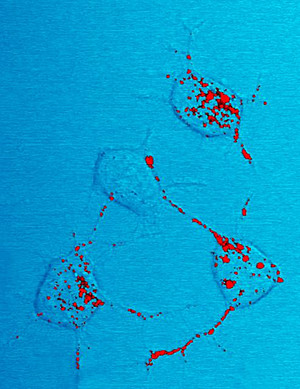Prion diseases: The fight against the holes in the brain

During the early stages, the person affected forgets minor tasks and functions. Trying to remember where the keys are or the way to a friend’s house. A little later in the illness, they forget how to wear a pair of trousers and start to stumble while walking, and eventually they do not recognize their spouses and children, their entire self-determined life, and can no longer lift an arm. We are referring to patients with prion diseases such as the Creutzfeldt-Jakob disease (CJD). These neurodegenerative diseases of the brain are quite rare but incurable. About one in a million people is affected. Research on non-human primates has been and still is indispensable for the investigation of the development, transferability, diagnosis and treatment of the disease.
Prion diseases such as CJD are also known as transmissible spongiform encephalopathies (TSE) and are not only transferrable in a specified species (eg, from human to human) but also from one species to another (for example, from cattle to humans in the case of BSE or mad cow disease). According to the latest research data, prions are the cause of these illnesses. These are protein structures (not like viruses or bacteria of living creatures), that occur naturally in the human and animal body. They can - for unexplained reasons – transform themselves into pathogenic proteins and cause damage. In the case of CJD, the prions can cause damage to the brain: clotted protein deposits accumulate, brain cells are destroyed, the tissue changes, develops holes and becomes “spongy” (spongiform).
Although prion diseases are usually considered infectious, they are not always transferred from one organism to the other. They could also be hereditary or spontaneous.
Sporadic form: The most frequent form is when CJD occurs spontaneously without any apparent cause (sporadic prion disease). Statistically this happens in Germany as mentioned about in one out of a million humans per year. 60 to 70-year-olds are mainly affected. In most cases, the survival period is usually less than one year.
Hereditary form: An inherited (genetic) prion disease such as genetic CJD, Gerstmann-Stäussler-Scheinker syndrome (GSS), or Fatal familial insomnia (FFI) is rarer. On average, the affected persons are slightly younger and the process is slower than in the case of the sporadic disease.
Transmitted form: Sometimes prions are transmitted from one person to another. Such a form of transmission can arise, for example during medical procedures: through contaminated instruments during brain surgery, during dura mater transplantations, or through growth hormone produced from human pituitary glands. Transfer from blood donations has already been established.
Video: Prions - Incurable Brain Dissolving Proteins
In this video the origin of prions and prion diseases are explained.
Since the beginning of the early twentieth century, research on prion diseases has been difficult because the pathogens function quite differently than for example those of viruses, bacteria or parasites. For this reason, it became clear that non-human primates were indispensable for the research of prion diseases. Ultimately, it had be clarified as to whether this unusual disease could be transmitted to primates (and thus also to humans). In 1966, Daniel Carleton Gajdusek and Clarence Joseph Gibbs demonstrated why CJD had to be regarded an infectious disease. They infected chimpanzees and later on other non-human primates such as rhesus monkeys and cynomolgus monkeys with the human variant of spongiform encephalopathy where they transferred material from the brain of diseased humans to the animals. The same process was applied for Kuru disease (a disease transmitted via cannibalism within the Fore region of Papua New Guinea).

The rodent model would have been a failure: rats, for example, do not take ill from this pathogen variant. In 1976, Gajdusek received the Nobel Prize for Medicine for the discovery of these novel infectious agents. In addition, the distribution of pathogens in the different organs of the CJD patients was also determined in experiments with non-human primates. Furthermore, nerve water, eyes, lung, liver, kidney spleen and lymph nodes were affected. Such findings are necessary in order to understand the spread of pathogens in the body and thus to also identify possible starting points to combat the problem. One of the possible ways to diagnose CJD is, for example, the detection of disease markers in spinal fluid. However, with this method it is still not possible to obtain a reliable diagnosis before the onset of the disease.
New variant - transmission through the consumption of meat from sick cattle
The danger lies in the fact that these prion diseases are still relatively poorly understood. This is evident in the example of the new mutant of Creutzfeldt-Jakob disease (vCJD): this variant of the disease often breaks out in younger patients. It is highly likely that it is transmitted to human beings through meat consumption of BSE infected cattle. The first cases were recorded in the 1990s in Great Britain but other cases have also been recorded in countries such as France and the USA. The new vCJD is transmittable to both mice and macaques. In the case of vCJD it is assumed that a genetic disposition of the patients increases the susceptibility of the infection. Nowadays, it is also assumed that vCJD can be transmitted through blood transfusions. In 2004, a similar case was found in the United Kingdom.
Successful prion research at the DPZ
A number of successful research projects on prion and prion diseases based on animal experiments with primates have been researched at the DPZ over the past few decades. Topics included the risk of infection and research of certain regulatory micro-RNA for the production of nerve cells or the significance of endogenous retroviruses for the development of the disease.
With the help of experiments in non-human primates at the German Primate Center, Prof.Walter Bodemer and his team of researchers developed some of the first prion antibodies in the mid-1990s. The quick test was intensively applied in 2000 during the European BSE crisis. Antibodies are proteins that are usually formed by the immune system of vertebrates in response to certain substances. BSE is the abbreviation for bovine spongiform encephalopathy and is a prion disease that occurs mainly in cattle. In 1999, Bio-Rad introduced the first BSE quick test based on antibody research at the DPZ. With the rapid test, we were able to identify pathogenic prion proteins in the brain tissue of slaughtered cattle. This and other tests were used to test slaughtered cattle for BSE in Germany until 2015. This method was used to prevent contaminated meat from entering the food chain and in so doing, prevent illnesses. The last case was reported in 2014. The rapid test is one of the reasons why there have been no cases of the new form of the Creutzfeldt-Jakob disease (vCJD) in Germany.
Links
Website of the coordination office of the TSE research of Lower Saxony
Information about prion diseases on the NIH website
Information about the Creutzfeldt-Jakob disease on the NIH website
Keyfacts about the variant Creutzfeldt-Jakob disease on the WHO website
